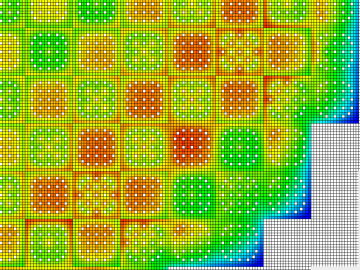
Filter News
Area of Research
- (-) Nuclear Science and Technology (13)
- (-) Supercomputing (58)
- Advanced Manufacturing (22)
- Biology and Environment (98)
- Building Technologies (1)
- Computational Biology (2)
- Computational Engineering (2)
- Computer Science (8)
- Electricity and Smart Grid (3)
- Energy Science (187)
- Functional Materials for Energy (1)
- Fusion and Fission (11)
- Fusion Energy (7)
- Materials (51)
- Materials for Computing (10)
- Mathematics (1)
- National Security (28)
- Neutron Science (25)
- Nuclear Systems Modeling, Simulation and Validation (1)
- Quantum information Science (1)
- Sensors and Controls (1)
- Transportation Systems (2)
News Topics
- (-) 3-D Printing/Advanced Manufacturing (8)
- (-) Advanced Reactors (12)
- (-) Artificial Intelligence (37)
- (-) Biology (11)
- (-) Grid (5)
- (-) Transportation (6)
- Big Data (22)
- Bioenergy (9)
- Biomedical (19)
- Biotechnology (2)
- Buildings (4)
- Chemical Sciences (5)
- Computer Science (97)
- Coronavirus (14)
- Critical Materials (3)
- Cybersecurity (9)
- Energy Storage (8)
- Environment (23)
- Exascale Computing (26)
- Frontier (32)
- Fusion (9)
- High-Performance Computing (43)
- Isotopes (7)
- Machine Learning (15)
- Materials (15)
- Materials Science (19)
- Mathematics (2)
- Microscopy (7)
- Molten Salt (5)
- Nanotechnology (11)
- National Security (8)
- Neutron Science (17)
- Nuclear Energy (39)
- Partnerships (1)
- Physics (10)
- Polymers (2)
- Quantum Computing (20)
- Quantum Science (25)
- Security (6)
- Simulation (16)
- Software (1)
- Space Exploration (8)
- Summit (43)
Media Contacts

A developing method to gauge the occurrence of a nuclear reactor anomaly has the potential to save millions of dollars.

It’s a new type of nuclear reactor core. And the materials that will make it up are novel — products of Oak Ridge National Laboratory’s advanced materials and manufacturing technologies.

As CASL ends and transitions to VERA Users Group, ORNL looks at the history of the program and its impact on the nuclear industry.

ORNL researchers have developed an intelligent power electronic inverter platform that can connect locally sited energy resources such as solar panels, energy storage and electric vehicles and smoothly interact with the utility power grid.

The Department of Energy’s Office of Science has selected three Oak Ridge National Laboratory scientists for Early Career Research Program awards.

Scientists at the Department of Energy Manufacturing Demonstration Facility at ORNL have their eyes on the prize: the Transformational Challenge Reactor, or TCR, a microreactor built using 3D printing and other new approaches that will be up and running by 2023.

Scientists have tapped the immense power of the Summit supercomputer at Oak Ridge National Laboratory to comb through millions of medical journal articles to identify potential vaccines, drugs and effective measures that could suppress or stop the

For the second year in a row, a team from the Department of Energy’s Oak Ridge and Los Alamos national laboratories led a demonstration hosted by EPB, a community-based utility and telecommunications company serving Chattanooga, Tennessee.

Researchers at the Department of Energy’s Oak Ridge National Laboratory are refining their design of a 3D-printed nuclear reactor core, scaling up the additive manufacturing process necessary to build it, and developing methods

In the 1960s, Oak Ridge National Laboratory's four-year Molten Salt Reactor Experiment tested the viability of liquid fuel reactors for commercial power generation. Results from that historic experiment recently became the basis for the first-ever molten salt reactor benchmark.


